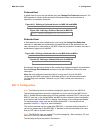
MSS User Guide 5: Using the MSS
5-2
TCP/IP Socket Connections
Note: TCP/IP socket connections applies to MSS-VIA only.
The MSS supports TCP/IP socket connections to ports 2001 and 3001.
Note: Starting with firmware v3.6/8, the MSS-VIA supports socket connections to port
2002 and 3002 also (to reach the DB9 serial port).
Opening a TCP session to a 300n port will form a raw TCP/IP connection to the serial
port. Use a 200n port when you need Telnet IAC interpretation.
To specify a connection to a socket, use the Telnet command followed by the MSS IP
address (or resolvable name), a space, and the desired socket number.
Figure 5-1: TCP/IP Socket Connection for MSS-VIA
% Telnet 192.168.0.10 2001
Interactive Connections
Interactive mode refers to entering commands at the Local> prompt. Commands can be
used to configure the MSS, connect to remote services, manipulate a connection, or
receive feedback. Interactive use requires an input device, such as a terminal.
Outbound Connections
When logged into the MSS, users can make basic outgoing connections using the
method described in this section. See the MSS Reference Manual on the CD-ROM for
more information about incoming and outgoing connections.
Telnet
To start an outgoing Telnet session, type Telnet at the Local> prompt, followed by either
the host's name or its numeric IP address.
Note: If a preferred service has been configured, a host name is not required.
Figure 5-2: Telnet Connection
Local> TELNET 192.168.0.10
Note: Initiate outgoing Telnet sessions from the serial ports. Incoming Telnet sessions
cannot initiate an outgoing Telnet session.
You can also make a Telnet connection to a specific port number, as described in Serial
Tunnel.
Rlogin
Rlogin allows a user to log into a remote host as if he or she were a local user. In the
example below, shark is the remote host and lola is the username. Unless the username
is password protected, the user will be logged in normally.
Figure 5-3: Connecting with Rlogin
Local> RLOGIN shark "lola"


















